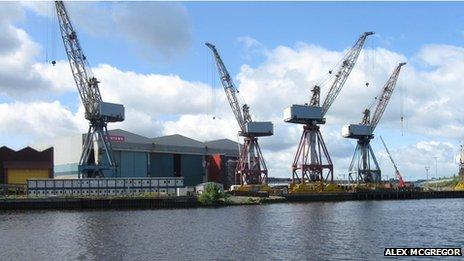Clyde shipyards slim down, again
- Published

At Govan, two huge sections are being built for each of two new aircraft carriers
As almost all other shipbuilding disappeared off down the Clyde slipway, Govan and Scotstoun have survived on the strength of Ministry of Defence orders.
In an era of specialisation, they're very good at building very complex ships - so specialised, however, that they're not so good at winning export orders for less sophisticated navies. That's just one of the problems afflicting Britain's remaining shipyards.
European rules allow governments to place military orders in their own countries, to protect strategic capacity.
That's no guarantee of work though. Whitehall has not put all its spending into UK yards. Koreans are currently at work on a Royal Navy order to build support ships, including oil tankers.
Without that work, there's a big gap in the Clyde's order book after the last section of aircraft carrier has been floated down river and round the north of Scotland to Rosyth in Fife, where the carriers are being assembled.
At Govan, they've been building two huge sections for each ship. Two have been floated to Fife already, and the other two will be floated out by late 2015.
A much smaller section of the superstructure of each ship is being built at Scotstoun, with one already delivered. Other parts of the ship are being built at five other locations around the UK.
Intense negotiations
Assembling the biggest Royal Navy ships ever, at 65,000 tonnes each, is being done on a hugely impressive scale, and it's got a budget to match. It started at £3.7bn six years ago.
This week, we expect it to rise again to £6.2bn, not least because the incoming coalition government changed the specification for the deck, and then changed it back again.
Part of the intense negotiations with BAE Systems has been how much of that extra cost, and future overruns, is going to be met by the private firm rather than the taxpayer.
Government austerity measures have meant a cutting back on the budget for aircraft that go on the carriers, and it's far from clear that there's enough finance to ensure both ships will be fully operational.
Global combat ship
Of 3,200 BAE workers based at Govan and across the river at Scotstoun, around 700 are working, on rotation, on the carrier contract at Rosyth.
So that leaves around 2,500 workers with nothing to do once the fourth hull section is floated out. The plan was to smooth the path onto the next contract.
A memorandum of understanding was signed in 2009 between the Ministry of Defence and BAE Systems. It was for 13 global combat ships to be built by 2026.

About 700 workers at Govan and Scotstoun are working on the aircraft carrier contract at Rosyth
That's a versatile replacement for the ageing fleet of Royal Navy Type 23 frigates, and it should be able to do much more than the frigates' anti-submarine specialism. Some 550 designers are at work on the project in Glasgow, Portsmouth and Bristol.
One thing they should be able to do is to attract export orders. By designing options for different weapon systems, and different capabilities, the idea is to sell the design to other navies.
BAE has sold its patrol ship design, but with a catch. Customers in emerging economies want to build up their shipbuilding capacity rather than rely on Europe. So the most recent BAE patrol ship, for the Thai navy, has just been built at a shipyard near Bangkok.
If the Type 26 design proves attractive to the countries which have shown some interest, including Brazil and Canada, then it might be on condition that they're locally built, denying work to BAE yards in Britain.
The MoD/BAE Systems memorandum of understanding made clear that it was unlikely all three BAE yards would survive if there were no export orders.
Portsmouth has been seen as the most vulnerable to closure. It's got 1,200 shipyard workers, though the BAE site there has 4,100 staff in total, with the majority servicing the fleet and working on combat systems, torpedoes and radar.
'Maritime nation'
And talking of locally built, the politics of this obviously becomes entangled with the debate over Scottish independence.
Supporters of Scotland's place in the UK say that it has to stay part of the union if it is to get the favourable treatment given by the Ministry of Defence in London to domestic military shipyards.
But Nicola Sturgeon, the SNP's deputy first minister, has written in Glasgow's Evening Times of her concerns about the yards' future.
"I simply don't accept," she writes, "that, in a maritime nation like Scotland, we shouldn't, or we can't, support both of these shipyards.
"Other countries similar in size to Scotland, like Norway, have shipbuilding industries much bigger than ours.
"If Scotland becomes independent, it will be for Scottish governments, working with industry, to support our shipyards - through our own naval procurement, support for exports and where appropriate, diversification away from military contracts.
"And speaking for the government I am part of, we would certainly do so. But right now, responsibility lies with the UK government."
I hesitate to write the overused term 'iconic', but that's what the shipyards are for the Scottish economy. The threat to their future will surely be a significant factor in the referendum debate.